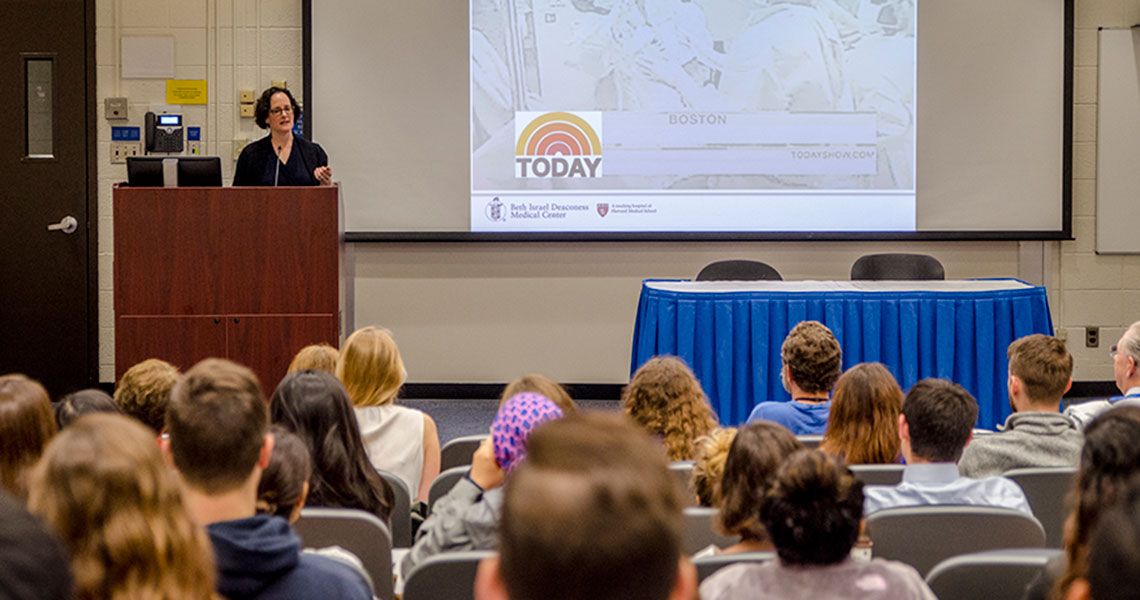The Today Show camera crew arrived early, recalled Toni Huebscher Golen, MD, RESD ’95, vice chair of the Department of Obstetrics and Gynecology at Beth Israel Deaconess Medical Center in Boston. In 2009, as the new medical director of labor and delivery at the hospital, Golen had jumped at the idea of a live, 8 a.m. telecast of a birth. Given the unpredictability of babies’ arrivals, however, she made a simple decision – but it was one that would have serious, but ultimately positive, ramifications for her unit and her future patients. She and the producers opted to air a scheduled Cesarean (C) section.
“We delivered this baby, and it was really cool,” Golen said, adding that medical correspondent Nancy Snyderman was in the operating room for play-by-play commentary, while anchor Meredith Vieira participated from the New York City studio. Given the patient and her husband’s family history of large babies and the patient being past her due date, the C-section was viewed by all three as a reasonable decision.
“It was a really exciting morning, and everyone was totally hyped,” Golen continued, “but this was right when online comments started to be a thing, and they started to stream in.”
The comments were largely negative and critical of the decision to promote a C-section. “I basically at this point thought, ‘I’m going to quit my job.’ I was completely, 100 percent misguided,” Golen said. “I think it’s a cautionary tale, but it got me thinking: ‘Well, [is a C-section] really a problem, and what can I do about it?’”
Typical of her personality, Golen picked the problem apart, figuring out piece by piece why her hospital should lower the Cesarean delivery rate. It was a thoughtful, evidence-based approach that her former professor, Allan B. Weingold, MD, HON ’98, would have approved.
“Dr. Weingold’s passion was education,” explained Nancy Gaba, MD ’93, RESD ’97, Oscar I. and Mildred S. Dodek and Joan B. and Oscar I. Dodek Jr. Professor and Chair of the Department of Obstetrics and Gynecology at the George Washington University School of Medicine and Health Sciences (SMHS), at the Ninth Annual Allan B. Weingold, MD, Obstetrics and Gynecology Lecture. The lecture was made possible through support from the Allan B. Weingold, MD, Obstetrics and Gynecology Fund, which the Weingold family created in 2005, with additional donors. “I think it’s only fitting to have a lecture that he and [his wife] Marjorie are sponsoring because it really fits in line with our department’s priority in making sure we are all educated about the cutting-edge [developments] in obstetrics and gynecology.”
Gaba added that Golen, the featured speaker at the lecture, was always ahead of her time as a resident at SMHS; her focus was on health care quality and patient satisfaction, with an emphasis on evidence-based medicine – fitting, as her lecture topic at the Sept. 13 event was “Quality Improvement and Culture Change Lowers the Cesarean Delivery Rate.”
The Cesarean delivery rate, Golen explained, has had a greater rise in the United States than most developed countries. It’s the most common major surgical procedure, but it’s performed independently of age, racial group, and gestational age. Because the variation in the procedure isn’t based on maternal, fetal, or hospital factors, the delivery rate is amenable to interventions. In other words, “whenever you see variation in a practice or a procedure or something that we as physicians do that’s unexplained by other medical factors, think quality improvement,” Golen said.
The problem with the Cesarean delivery rate, as well, is that there tends to be greater blood loss, prolonged recovery time, and additional complications, such as venus thromboembolism, infections, and wound problems. “Mothers die,” Golen stressed. “If you don’t say it specifically to patients, I bet you we imply it to patients, which is that [a Cesarean] is better for the baby. And that’s the problem – it’s not necessarily better for the baby.”
To illustrate this point, Golen dissected the Cesarean delivery rate into five parts, each with a hypothesis and interventions: fetal heart-rate tracings, patience with labor, VBAC (vaginal birth after Cesarean) deliveries, effective labor and delivery management, and auditing and feedback for providers. She found that by standardizing interventions – use of better terminology, diagnosing active labor at 6 centimeters, more efficient and effective unit management, and actionable feedback – resulted in a significant drop in Cesarean delivery rates.
The project, which started in 2007, had a base of 35 percent, the amount of Cesareans performed from 2005–07. By 2015, the Cesarean delivery rate at Beth Israel Deaconess was 23 percent.
“Overall, it’s been quite successful,” Golen said. The critical factor, she added, is recognizing that the vast majority of births, regardless of vaginal or Cesarean deliveries, involve healthy mothers and healthy fetuses. Providers, she argued, tend to emphasize the catastrophic – and rare – cases, which may inadvertently lead to greater intervention during the labor and delivery process, resulting in the uptick in Cesarean procedures.
“Really, what we’re trying to focus on is improving outcomes for the entire population, and in order to [do that], these are the kind of people that we actually need to focus on: the healthy people,” Golen said. “In the big picture of the population, if we decrease the Cesarean delivery rate in folks like this, then we’ll have made a greater impact.”



